AMD Radeon RX 480 Graphics Card Roundup
Reference AMD Radeon RX 480
Why you can trust Tom's Hardware
Aside from the fact that AMD is first alphabetically, we also wanted to cover the company's card first for another reason. Reference designs often have to defend against the perception that they're not as good as what follows from board partners. And in this case, that's not entirely true.
AMD didn't do a bad job with this card. That much is evident after testing a number of third-party alternatives. In fact, in a closed case, the centrifugal cooler that exhausts waste heat may even outperform some of the factory-overclocked boards with axial fans in certain metrics.
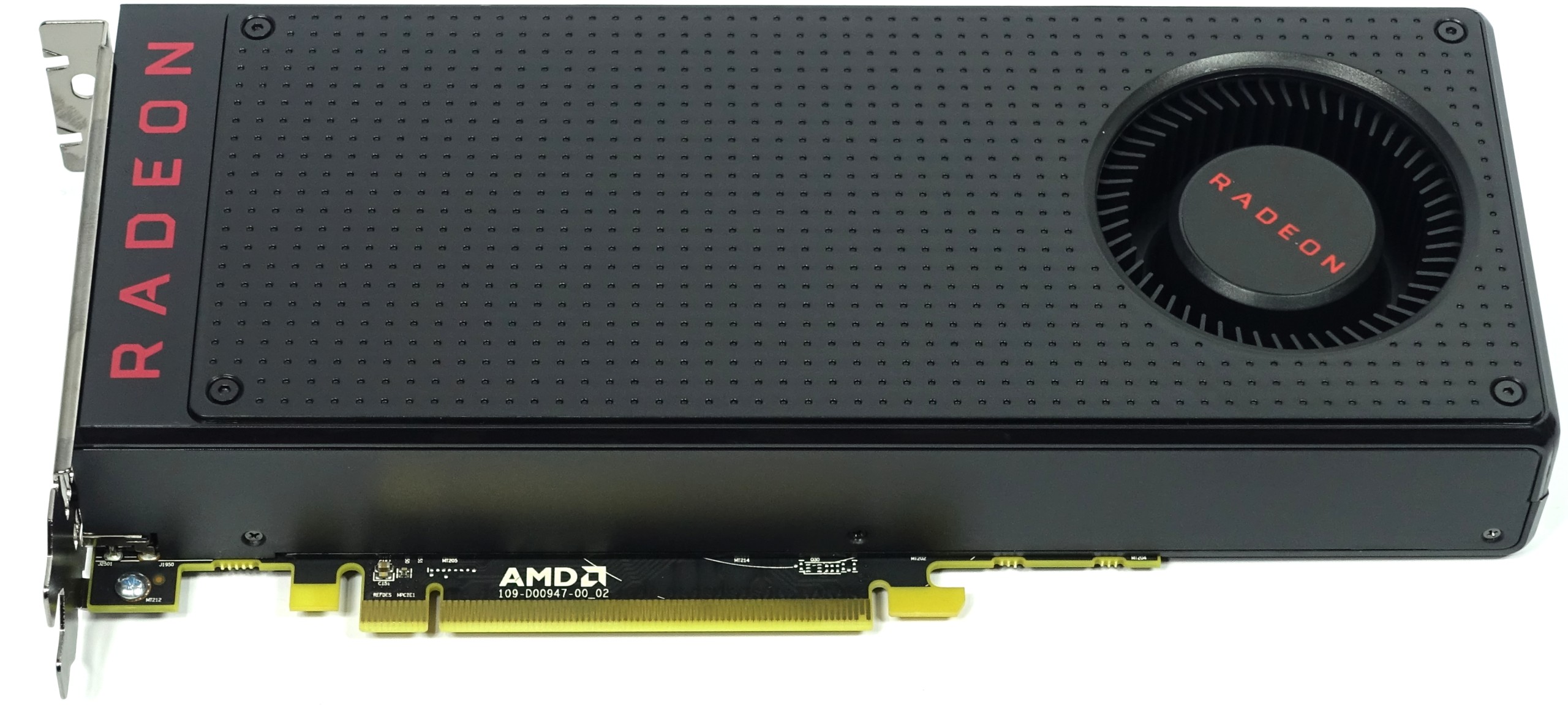
In an effort to generate results from a newer sample, we got our hands on another reference card and repeated the measurements from our launch coverage. Even if the results differ a bit, we considered it more fair to test with a more recent chip than one of the first, especially since our equipment changed a bit as well.
Specifications
MORE: Best Graphics Cards
MORE: Desktop GPU Performance Hierarchy Table
MORE: All Graphics Content
Exterior & Interfaces
The card weighs just 24.1 ounces (685 grams), is 24.2cm long, 10.5cm tall, and 3.5cm wide. At first glance, its dimensions look similar to AMD's Radeon R9 Fury Nano. However, a closer look reveals several cost-cutting measures compared to the previous generation's highest tier.
The black plastic body is one piece, even if the four supposed Allen screws suggest otherwise. They're merely a ruse to hint that this is a multi-part design.
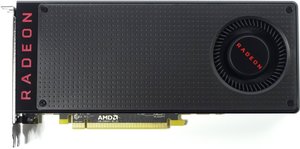
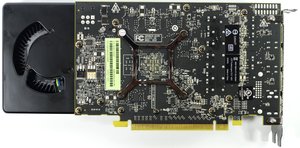
Around back, we see that the actual PCB is only 18cm (or eight inches) long. We've seen this sort of overhanging radial fan and bottom-facing air intake before from Nvidia.


Up top, next to the Radeon logo, the card features a single six-pin auxiliary power connector. It's barely ample, as we saw in our launch review and AMD Radeon RX 480 Power Measurements Repeated And Clarified. There should be an eight-pin connector in this spot, and we'll go into more detail about that shortly.
A fully closed end encourages air to flow from the fan out through the front bracket, keeping it from heating up any of your other components.


AMD eliminates DVI output from the output bracket to make more room for ventilation holes. You can still attach up to four monitors simultaneously, though, via three DisplayPort 1.4-ready connectors and an HDMI 2.0 interface.
Board & Components
A look at the PCA reveals that the VRMs are moved near the output bracket. We consider this to be counterproductive, and we're not sure why AMD went that route. The Ellesmere GPU, bare of any identifying markings, is situated diagonally in its package, similar to older Radeon graphics cards.
AMD goes with Samsung GDDR5 memory modules (model number K4G80325FB-HC25). Each one has a capacity of 8Gb (32x 256Mb). And depending on clock rate, they can operate at voltages between 1.305V and 1.597V. Their ceiling is 2000 MHz, similar to what we find on Nvidia's GeForce GTX 1070.

Zooming in for a closer look at the board, we find International Rectifier's IR3567B dual-output 6+2-phase PWM controller. AMD started using this buck controller as far back as the Radeon R9 290. It's the heart of the company's power supply and is well-documented. That makes programming control and overclocking utilities for the RX 480 much easier.
Six phases are used to supply the Ellesmere GPU with power. Unlike Nvidia, which uses one dual N-channel MOSFET for the job, AMD relies on two single N-channel MOSFETs per phase. There's one MDU1514 (30V, 66.3A, 6mΩ) and one MDU1511 (30V, 100A, 2.4mΩ), controlled by an IR CHL8510 high-performance gate driver.

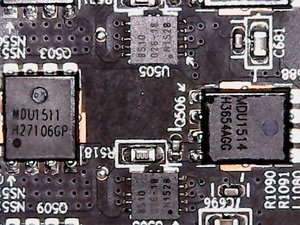
The seventh phase supplies power to the memory modules, and in contrast to Fiji-based cards, it uses the motherboard slot's 3.3V rail. This makes the design significantly simpler, especially since the modules don't consume much power. In this one regard, we're glad the RX 480 doesn't follow the Radeon R9 Fury X/Fury/Fury Nano's lead in hosting the gate driver on the PCB's back side, directly behind the MOSFETs, creating serious hot-spots.
Power Results
Even after adjusting the drivers and enabling AMD's compatibility mode, the reference card's power consumption is still above its 150W TDP, though just barely.
During our gaming loop, the card consumes 157W. We measured just above 158W during the stress test. AMD's Radeon RX 480 simply can't go much higher.
We mention short load peaks only as a side note (see the light-grey bar in the chart below), since they're rarely relevant in practice. Nevertheless, they illustrate the importance of deploying a reasonably-sized secondary side for the power supply (low-impedance caps).
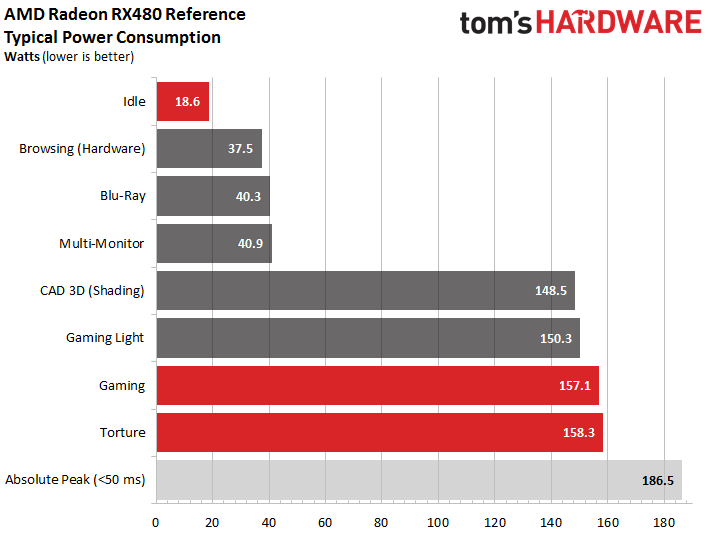
The following two graphs represent two minutes captured from the gaming loop and stress test. These are what our average power consumption figures are calculated from:
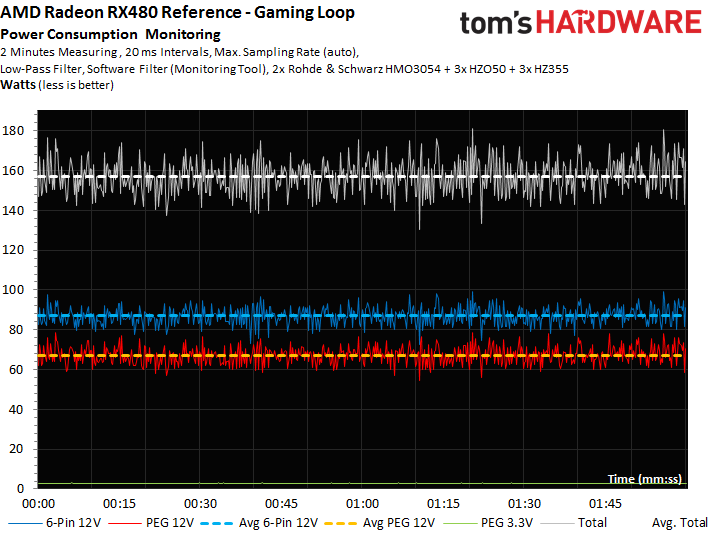
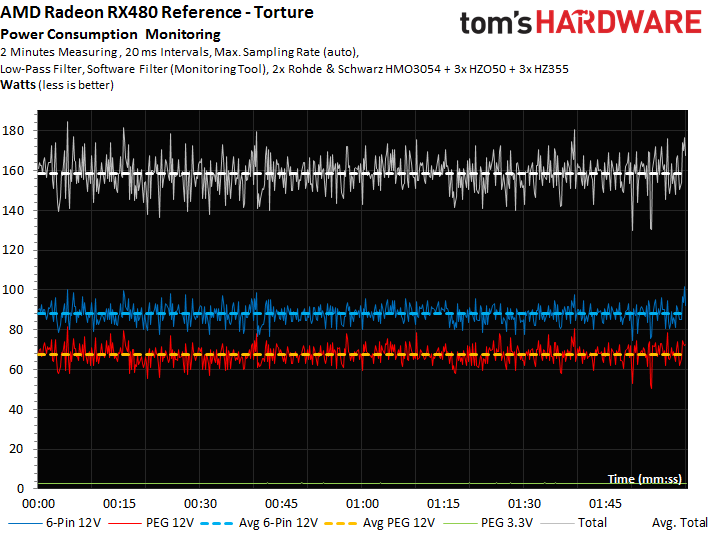
The next two graphs map current measurements at each of the supply rails, corresponding to the power consumption levels shown in the diagrams above:
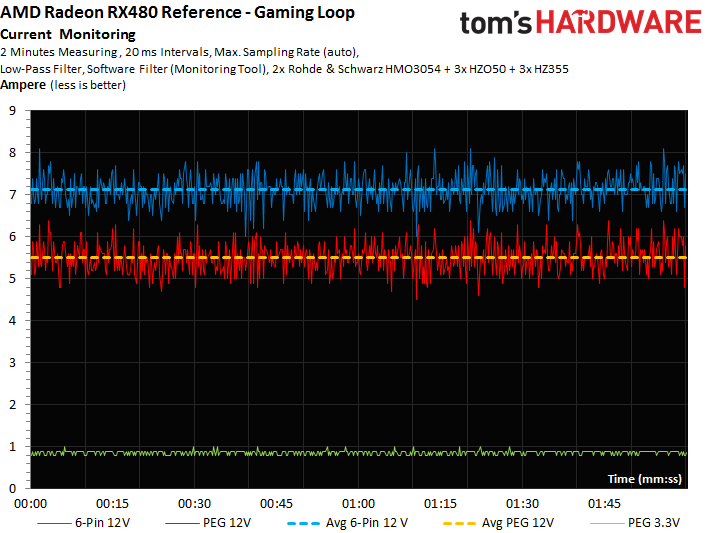

What we see is an almost perfect match. Think back to our Radeon RX 480 launch coverage: it was a nonstandard load on the motherboard slot's 12V rail that forced AMD to publish its driver-based fix. Thanks to the compatibility mode function, everything now seems to be in order.
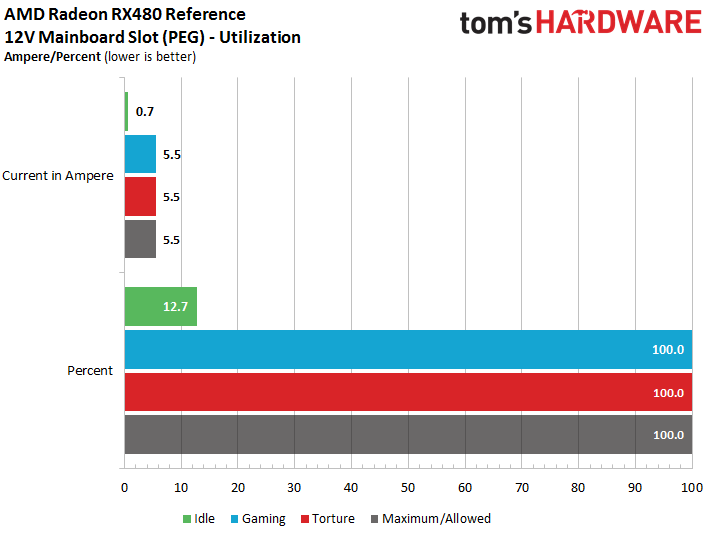
If you own an older motherboard, we still recommend using AMD's compatibility mode to avoid potential problems. Owners of newer platforms have nothing to worry about, though.
Temperature Results
Pulling the shroud off is easy after removing six screws on the side. Under the cover, you'll find a simple heat sink with fins, a larger frame for stabilization and cooling, and a radial fan. We've seen the fan before, though this time its maximum rotational speed is set at 5000 RPM.
From this angle, it's clear that the Radeon RX 480 employs direct heat exhaust cooling, where waste heat is dissipated through the sink and blown out through the slot bracket.
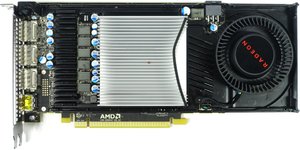
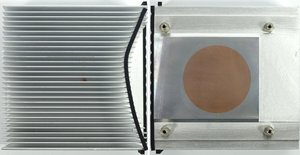
The heat sink is a simple piece of extruded aluminum with an embedded copper core to improve thermal conductivity above the GPU. A strip glued to the top of the fins ensures that the air doesn't leak out above the cooler, but instead passes through it entirely.
A frame underneath the heat sink serves double duty, helping cool the memory modules and MOSFETs. Fins in the frame help increase its surface area somewhat.
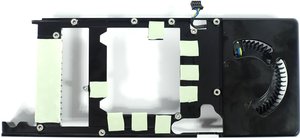
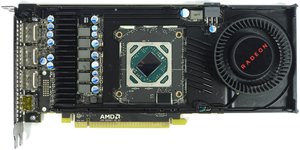
The cooling performance that AMD achieves isn't bad. During our gaming loop, the Radeon RX 480 sustains an average frequency of about 1225 MHz, and only sporadically drops by a few megahertz. The reasons for this are tied to an imposed power limit, which makes itself known at certain points under taxing workloads.
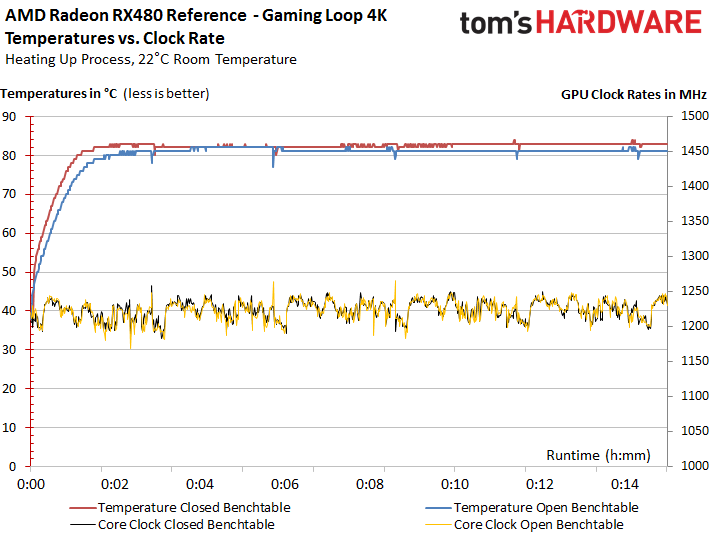
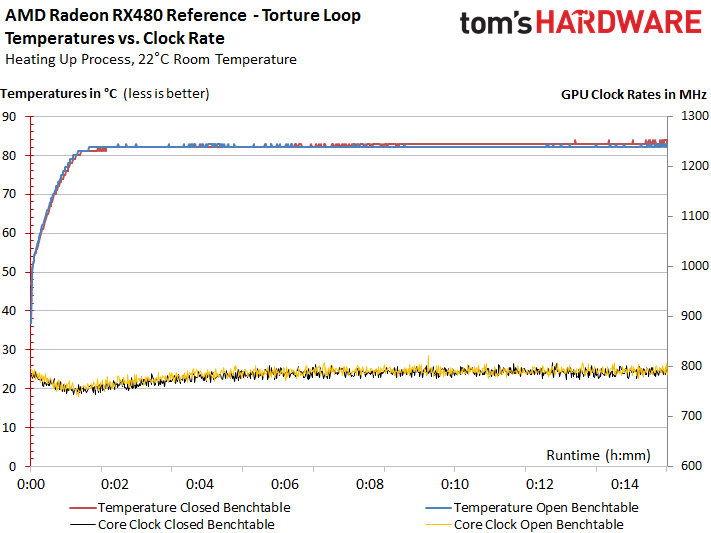
As we've come to expect from direct heat exhaust-based graphics cards, temperature measurements in an open test bench and closed case are very similar. Only the GPU is marginally warmer, but this could very well be caused by a higher ambient temperature inside of our enclosure.
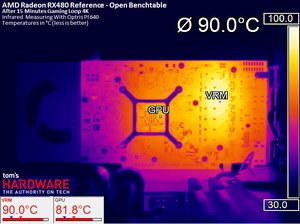
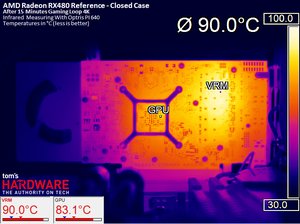
The values are again similar during our stress test, showing minimal difference between the open and closed setups. In a case, the slightly higher temperature comes from a minor increase in power consumption.
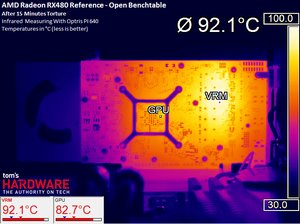
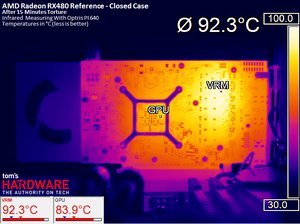
Regardless of whether you're in an airy tower or a cramped form factor, AMD's reference Radeon RX 480 sports sufficient cooling. The only worrisome measurement we collected came from a memory module that hit 181°F (83°C), which is just below the maximum specified by Samsung.
Sound Results
Often, the trade-off for blowing hot air out of your case is a less pleasant-sounding fan. How does the RX 480's thermal solution sound as it facilitates consistent cooling performance?

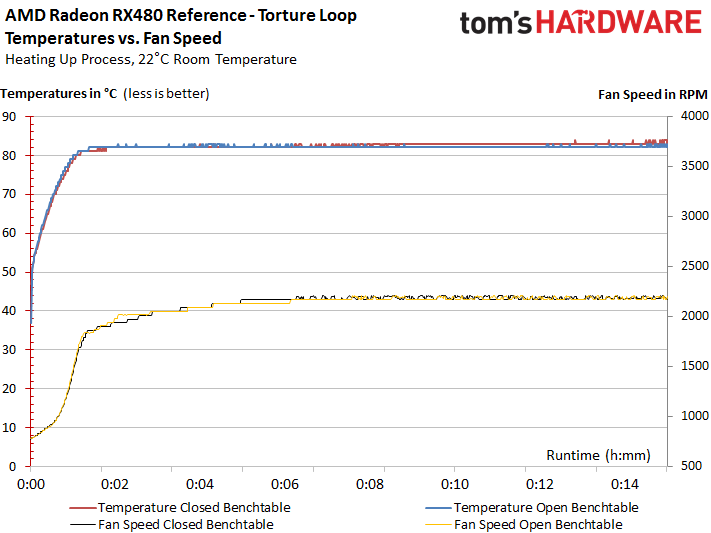
Once the RX 480 reaches its maximum temperature in our gaming loop, the 41.9 dB(A) reading we collect is—up to the decimal point—identical to what we saw in our launch coverage. That's no surprise, given the same fan speeds. But it's always good to see consistency, even months later.
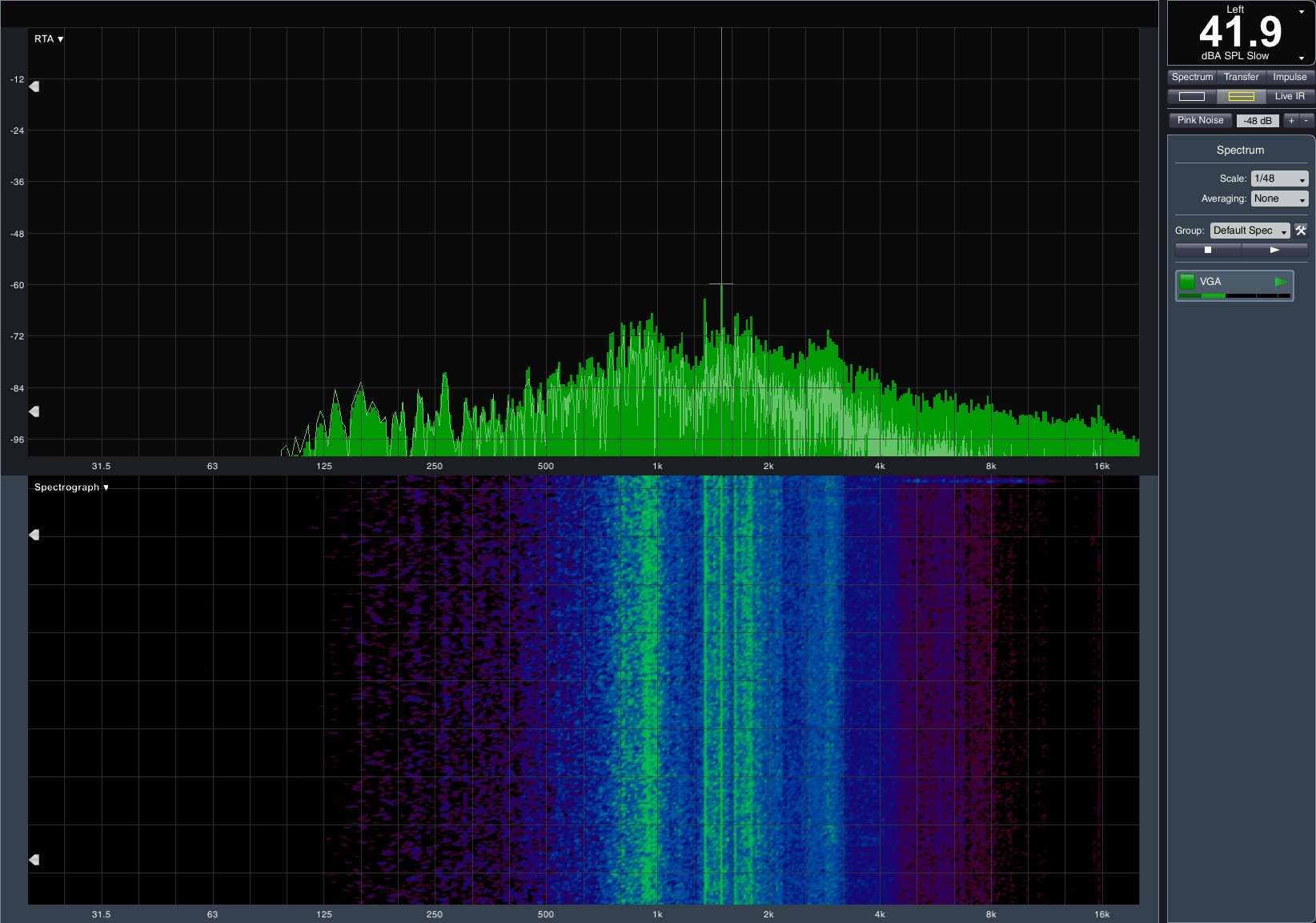
At idle, a measurement of 31.1 dB(A) is slightly lower than what we saw previously. At low speeds, however, the radial fan does sound rather unpleasant, almost like growling. The spectrum contains some dominant low-frequency parts.
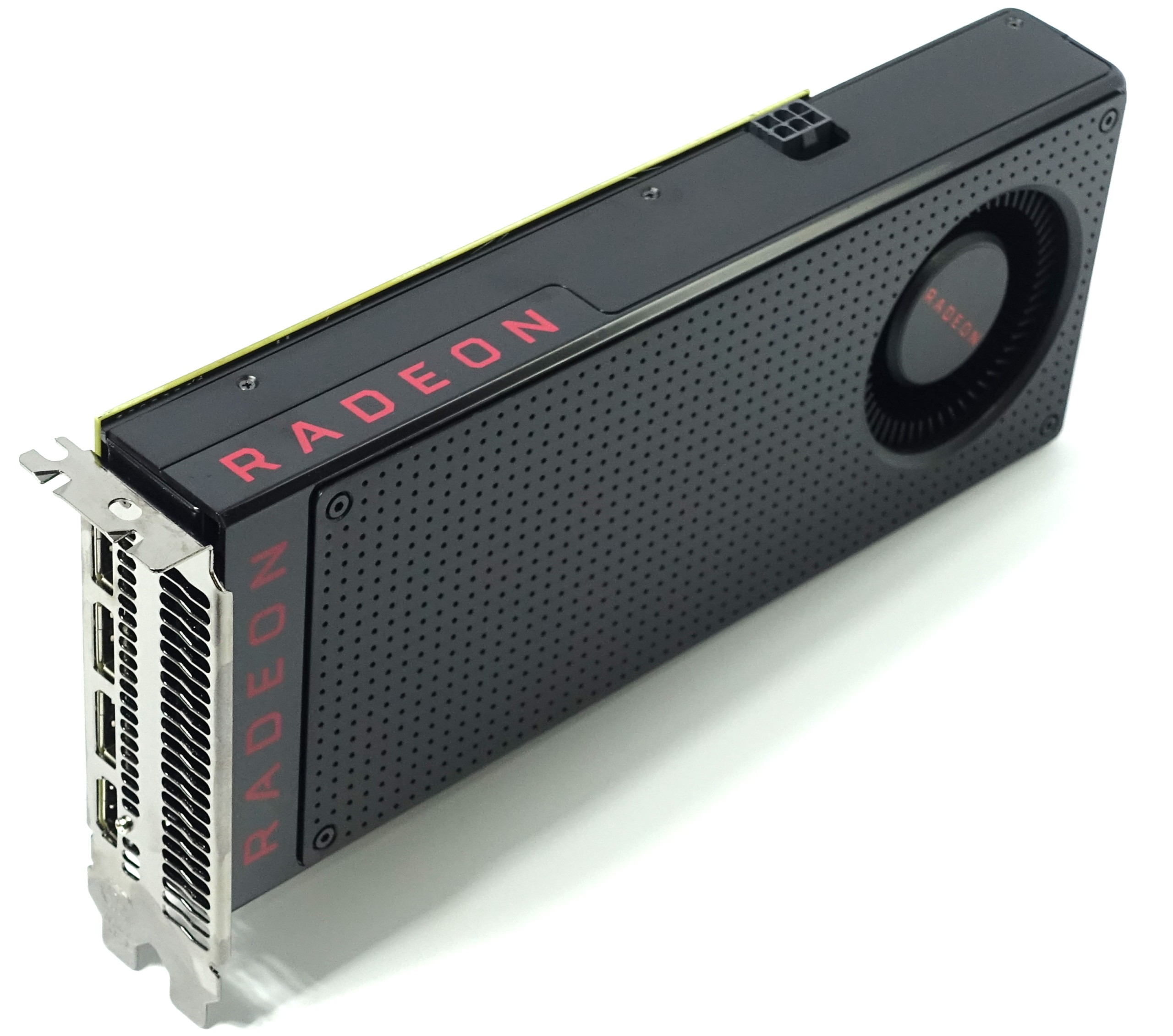
This reference card isn't bad. We've certainly seen reference-class hardware from both AMD and Nvidia that fared worse. Thanks to a driver update that rectified the issues we identified in our launch coverage, AMD's Radeon RX 480's power supply is much better balanced. It's even possible to optimize this card further through WattMan, since chip quality seems to have improved and the voltage presets are higher than they need to be.
AMD's cooling performance is quite convincing, and the fan is acoustically tolerable, despite high RPM values. In fact, this reference implementation really has no reason to shy away from comparisons with partner boards. Can it outshine any of them, though? That remains to be seen.
AMD RX480 Reference
Reasons to buy
Reasons to avoid
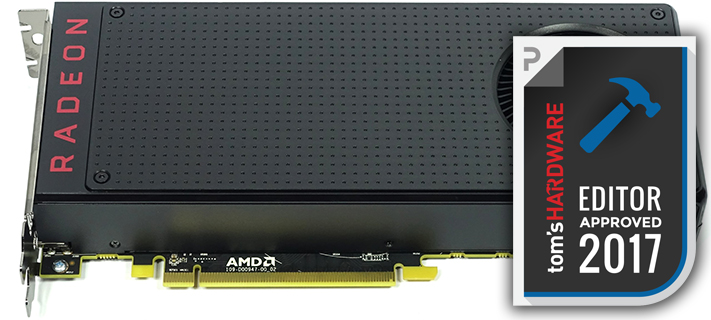
MORE: Nvidia GeForce GTX 1080 Roundup
Current page: Reference AMD Radeon RX 480
Prev Page Power, Sound & Temperature Benchmarks Next Page Asus ROG Strix RX 480Stay On the Cutting Edge: Get the Tom's Hardware Newsletter
Get Tom's Hardware's best news and in-depth reviews, straight to your inbox.
-
alchemy69 Not sure where you found a reference card for $180 but it sure as Hell wasn't Amazon.Reply -
artk2219 You can find them on Newegg for around that much pretty often. Also the R9 Fury is a hell of a mixed bag, Some games its matching a 1070, others its below the 480. Weird.Reply -
techy1966 I only ask because I have 2 390x cards and I get way better results than yours does here and yes with crossfire off mine is getting better results granted it is overclocked @1236mhz. Heck I just played watch dog 2 single card mode and got always above 60 fps here that card is getting 45 fps..just saying is all. Nice write up though. Just noticed GTA numbers as well and was WTH why is their 390x card sucking so much must be old old drivers I 'm sorry but even with crossfire off my numbers at 1080p are way higher maxed out. I do know I can beat a 480 in everything and slaughter it in crossfire will Vega ever get here already or do I have to slide over to the green team lol.Reply -
shrapnel_indie HIS has been missing from the U.S. Market for a few years now. As to noise, Yes we can measure it, and determine a loudness level, but tolerance is dependent on the individual as always. I still question the price links used as some are unrealistically high compared to the market Amazon competes in (Mail-Order.)Reply
Was the latest driver used? Was the BIOS updated in every card? -
digitalgriffin I am a bit perplexed as to why you love the ASUS Strix so much with a 6 pin power connector. Either it's pulling too much power over the PEG, or pulling too much power over the 6 pin. It really needs an 8 pin connector to stay in spec.Reply -
blppt "Also the R9 Fury is a hell of a mixed bag, Some games its matching a 1070, others its below the 480. Weird."Reply
The newest generation AMD cards (Polaris) are apparently designed to handle heavy Tessellation better than previous gens, so my guess is that would be the circumstances in which the RX480 beats the Fury. I would say it was the extra 4GB of frame buffer space, but we've seen that the HBM often negates that RAM shortage in many benchmarks. -
NewbieGeek Hmm. Interesting article. Personally never had temperature issues with my Sapphire Nitro rx 480 8gb. Maybe Tom's is defective? Mine runs at 1330mhz core 2020mhz ram without drops, even during intense gaming... And I've got a custom fan curve making the card quieter than stock...Reply